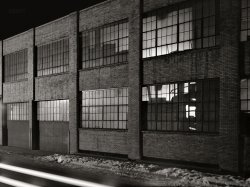
MAY CONTAIN NUTS

Search Shorpy
SHORPY ART

Framed or unframed, desk size to sofa size, printed by us in Arizona and Alabama since 2007. Explore now.
Join and Share
Ad-Free Shorpy
Shorpy is funded by you. Patreon contributors get an ad-free experience.
Learn more.

Recent comments
- Baked goods to go
- Tires
- A Certain Robot
- Still Standing
- All wound up?
- Springy
- This one is inspirational.
- Seasonal Work
- Tomaeto, Tomahto
- Truck ID
- Horton Hears a ...
- From a buggy company came ...
- They call me Mister Horton
- Still Run
- Someone fed Jack some bad info.
- A Beautiful Machine
- It's official.
- Olive Brand Sportswear
- I still have a grudge against Texaco
- No GPS?
- CFG Bank Arena
- Van Lines
- Closed Station?
- John Vachon
- Folding Chairs
- TEXAGO
- Fragi-lay
- Classy
- Passenger seat
- No tipping
Member Photos
The Shorpy
Printporium
Printporium
Search Shorpy
Search results -- 30 results per page
- Brakeman Capsey: 1943
- ... car as the train on the Atchison, Topeka & Santa Fe Railroad between Belen and Gallup, New Mexico, waits on a siding." ... 20, I repacked journal boxes on the wash track at the UP yard in LA. It was dirty work. I always ended up soaked in oil. The packing had ... Posted by Dave - 02/11/2014 - 11:29am -
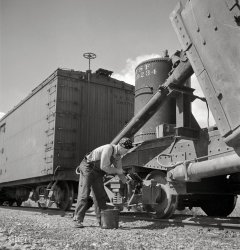
- Polar Express: 1942
- December 1942. Proviso classification yard of the Chicago & North Western Railroad. View full size. 4x5 Kodachrome transparency by Jack Delano.
... Posted by Dave - 07/30/2012 - 10:03pm -
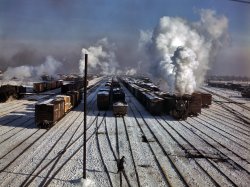
- Locomotive Makeover: 1942
- November 1942. "Illinois Central rail yard, Chicago. Locomotives in for repair at the roundhouse." Medium format ... is a 4-8-2, commonly known as a "Mountain" type. The railroad had 136 locos of this type, built by ALCo, Lima and the IC's own ... Posted by Dave - 04/26/2013 - 2:11pm -
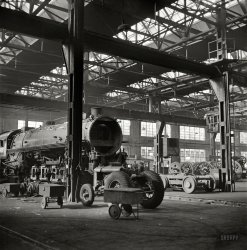
- Harbor Belt: 1943
- ... 1943. "Freight operations on the Indiana Harbor Belt railroad between Chicago and Hammond, Indiana. The train passes many ... Island is still a manual interlocking, as is 3) Gibson Yard west end tower. At one point most, if not all, of these towers were ... Posted by Dave - 01/23/2014 - 6:52pm -
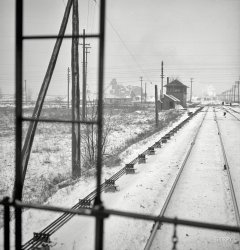
- Knock Knock: 1943
- ... 1943. "Freight operations on the Indiana Harbor Belt railroad between Chicago, Illinois and Hammond, Indiana. Locomotive coupled to ... of the whistle will let the crew and everyone else in the yard that she is about to make a reverse movement.
(The Gallery, Jack ... Posted by Dave - 10/07/2013 - 12:24pm -
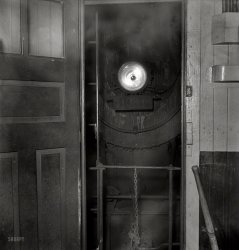
- Frosty the Brakeman: 1943
- ... Illinois. "Freight operations on the Indiana Harbor Belt railroad between Chicago and Hammond, Indiana. The Chicago & North Western Railroad yard." Photo by Jack Delano, Office of War Information. View full size.
... Posted by Dave - 11/06/2013 - 8:28pm -
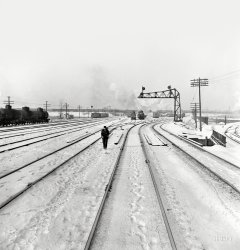
- Capitol Refining: 1925
- ... proposes to absorb the Washington and Virginia Stock Yard and Abattoir Company and to enlarge the plant and add equipment, not only ... has been recognized already by the establishment of a railroad stop and a postoffice by the United States government. The name is ... Posted by Dave - 09/11/2011 - 6:42pm -
![Capitol Refining: 1925 A glimpse at the industrial side of Washington circa 1925, labeled "Capitol Refining Co. plant." This tank farm, where the Pentagon stands today, was described at the time as being in "Relee, Alexandria County, just south of the highway bridge." National Photo Co. Collection glass negative. View full size.
OMG!I hate it when Giant Amoebas attack!
Cattle, Cotton & Oil, Oh My!I find it curious how this site evolved from a stockyard and abattoir (slaughterhouse) into a cottonseed oil refinery and then finally the petroleum refinery pictured. The cotton-seed oil may have been used for food or industrial applications such as lubricants and paint. I wonder if equipment for refining cottonseeds could be reused to refine petroleum?
[Were any of these petroleum tanks? - Dave]
Update: After seeing the later White Dome post, I am pondering if perhaps the "refining" refers only to vegetable and animal oils and not to petroleum products at all. I guess its my fossil-fuel-centric lifestyle that led me to the conclusion that this was a petroleum refinery - that and pre-conditioning due to the long series of photos of service stations on Shorpy.
Washington Post, Jun 5, 1908
Packing Plant For City
Washington's industries are to be increased here of a plant with an annual output valued at from $4,000,000 to $5,000,000. The company, to be known as the Columbia Cotton Oil and Provisions Corporation, proposes to absorb the Washington and Virginia Stock Yard and Abattoir Company and to enlarge the plant and add equipment, not only for slaughtering of cattle, but for the refining of crude cottonseed oil.
...
The proposed plant, it is said, will be the only one of its kind east of Chicago and south of New York, and the only complete compound plant on the coast between New York and Savannah.
...
The annual capacity, according to figures submitted to the manufactures committee of the Chamber of Commerce, will be 100,000 barrels of crude cotton-seed oil, 125,000 hogs, 10,000 cattle, and 25,000 sheep and calves which will be converted into lard, lard compound, lard substitute, cooking oils, lard stearine, oleo stearine, hams, bacon, sausage, canned meats, fertilizer, hides, and a variety of fresh cuts to be put on the market.
Washington Post, Jun 2, 1913
Refiners Buy Oil Plant
The Capitol Refining Company, which was recently granted a charter by the Virginia corporation commission, has purchased the plant of the Columbia Cotton Oil and Provisions Corporation, at Relee, near Arlington Junction, Alexandria county. The Capitol Refining Company is a subsidiary of the Jacob Dold Packing Company, an independent concern, whose main establishment is in Buffalo, N.Y., and its announced that about September 1, after extensive repairs to the plant, operations will be resumed.
Relee, Va.Is it possible that Relee stands for Robert E. Lee? His estate was nearby.
[You are correct. The use of Relee, Virginia, as a place name seems to have begun in 1909, with the establishment there of a post office, rail stop and telegraph office, all connected with the Columbia slaughterhouse and rendering plant in what used to be Alexandria County, at the current location of the Pentagon. By 1935, use of the name seems to have pretty much stopped. - Dave]
Washington Post, November 11, 1909
Finishing Big Plant
$450,000 Abattoir and Refinery Soon to Operate.
To Employ 200 Persons. Industry at Arlington Junction Will Help Virginians.
Within ten days the Columbia Cotton Oil and Provision Company will begin operation of its $450,000 plant, which has been building near Arlington Junction across the river for the last nine months, and will mark one of the greatest strides forward in the industrial development of Washington.
In the abattoir 4,000 hogs a week will be killed, and a strong demand will at once be created in Virginia and surrounding States for porkers. ... The cotton oil refinery and abattoir will be run in conjunction in the production of lard compound, which will be one of the most important outputs of the establishment.
... The plant essays the importance of a town which has been recognized already by the establishment of a railroad stop and a postoffice by the United States government. The name is Relee, in honor of R.E. Lee. It is Relee postoffice, Relee station, and Relee telegraph office, all of which are in operation.
Day of JudgmentCould the "accidental" location of the "cloud" be any better placed in terms of composition? Actually makes the shot better, I think.
(The Gallery, D.C., Natl Photo, Railroads)](https://www.shorpy.com/files/images/32665u.thumbnail.jpg)
- Smoke and Wreckage: 1939
- ... August 1939. "Centralia, Lewis County, Washington state. Railroad yard, looking down from highway bridge. Disaster to the town: The one remaining ... Posted by Dave - 10/05/2017 - 7:20pm -
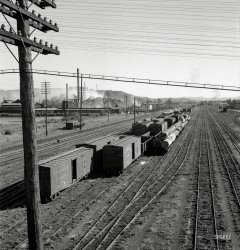
- Rail Hub: 1906
- ... is now) Interstate 95.
The picture is the Elevated yard west of the 69th Street Terminal.
At the time of the picture, the ... At left you can see the Philadelphia and Western Railroad's powerhouse, and one of their cars at the platform. To the right, the ... Posted by Dave - 08/14/2014 - 3:05pm -
![Rail Hub: 1906 Circa 1906. "Elevated railway terminal, 70th and Market streets, Philadelphia." 8x10 inch dry plate glass negative, Detroit Publishing Company. View full size.
100+ years laterIt looks like the 69th Street Transportation Center. There's a rail loop that climbs past a retaining wall that looks pretty similar. (At least it does to me, anyhow.)
Additional InformationFrom my brother, who lives in suburban Philadelphia. He's an expert on the history of rail services in that area. His collection of books on the subject is probably larger than most people's entire library:
It's the Market Frankford Elevated subway from 44th and Market to (what is now) Interstate 95.
The picture is the Elevated yard west of the 69th Street Terminal.
At the time of the picture, the Elevated extended across the Schuylkill before going underground at 22nd Street [I think that it now goes underground before the Schuylkill].
As we Philadelphians all know, "You can't get to heaven on the Frankford EL, cause the Frankford EL goes straight to Frankford." This subway was called the Frankford Elevated. It followed Market Street from 69th street (at the western city boundary) into Center City, then at the Delaware River turned north and ended in Frankford in northern Philadelphia.
Another Terrific ViewAn even better shot of the backside of the Terminal shows all the operations. At left you can see the Philadelphia and Western Railroad's powerhouse, and one of their cars at the platform. To the right, the tracks of the Frankford El, curving out from the platform and off frame to the yard. And finally the stub-ended tracks of the trolley lines. We see the neat little control tower, a large Brill car signed for Collingdale on the Sharon Hill line and its bow-tied motorman.
More interestingly (to me at least), just on the hairy edge of the frame at far right you can catch a glimpse of a horse and buggy and the fields beyond. Those fields represented the last farm in the increasingly suburban Upper Darby.
Marshall Jones, my neighbor, one of the last of the old-time farmers in this area of the country, would recall that farm fondly many years later. "I can remember my uncle's corn fields just across West Chester Pike from the 69th Street terminal building" he would write in his Recollections. But within a few years of this photograph, his father decided the area was becoming too crowded, and the family moved out to Westtown Township in Chester County. The farm here on 69th Street would be developed into a number of buildings, including the Tower Theater.
(The Gallery, DPC, Philadelphia, Railroads, Streetcars)](https://www.shorpy.com/files/images/SHORPY-4a18180a.thumbnail.jpg)
- Boxcar Brown: 1942
- ... worker at the Chicago & North Western's 40th Street yard, examining paint samples used on freight cars and coaches of the railroad." Paint your wagon, or color-coordinate your caboose. Kodachrome ... Posted by Dave - 11/22/2016 - 10:46am -
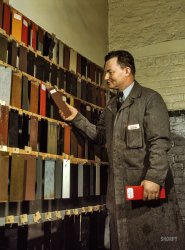
- Night Train: 1943
- ... California. A view of the Atchison, Topeka & Santa Fe yard at night." Medium-format negative by Jack Delano. View full size.
... examples of a locomotive type which was named after the railroad. They descend from the 2-10-0 "Decapod" type, to which the Santa Fe ... Posted by Dave - 01/07/2013 - 3:46pm -
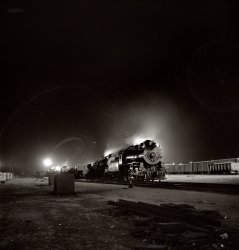
- Snow Belt Special: 1943
- ... 1943. "Freight operations on the Indiana Harbor Belt railroad between Chicago and Hammond, Indiana. The train pulls out of the Chicago & North Western yard." Photo by Jack Delano, Office of War Information. View full size.
... Posted by Dave - 03/17/2015 - 9:39am -
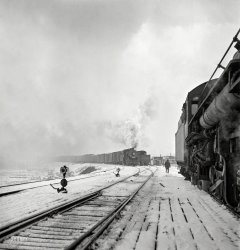
- Wakefield Hall: 1926
- ... and 30s one could rent a nice two-bedroom house with a yard and a garage for $20 to $30 a month, and frequently less. In the ... for sure, but fairly crowded with oilfield crews and railroad workers). He could easily afford it because he was making $75 a month ... Posted by Dave - 09/04/2012 - 3:58pm -
![Wakefield Hall: 1926 1926. "W.H. West Co., Wakefield." Wakefield Hall was "an imposing new apartment edifice" put up by W.H. West Co. at 15th and V streets N.W. in Washington. Rents: $60 to $160 a month. National Photo Co. View full size.
It rains only on one block of the street?Why is only part of the street wet, and none of the sidewalk? Clearly it isn't from rain, but what would it be from?
[Street cleaning. - Dave]
Sky-high Rents$60 to $160 a month was hugely expensive in 1926. The tenants must have been very well off to afford it. In most cities and towns in the 1920s and 30s one could rent a nice two-bedroom house with a yard and a garage for $20 to $30 a month, and frequently less. In the mid-1930s, my dad paid $15 a month for a comfortable house in Casper, Wyoming (not Washington, for sure, but fairly crowded with oilfield crews and railroad workers). He could easily afford it because he was making $75 a month as a telephone lineman.
Still there......and looking much the same, although the street scene has changed a lot over the past 83 years.
View Larger Map
Not So Sky-High ActuallyRent at $60 would just top a bit over $700 today, which for an urban location, no matter what city, is actually a bargain. There may have been a number of choices in the gap to $160 also, and many people today would jump at the chance to have that low a rent! Murphy beds and fold-in ironing board as well as dumbwaiter garbage collection and a doorman were in fashion & high regard and the smart set would be flabbergasted with these digs.
Still there and still a rentalThough now, instead of sky-high rents, it's a rent controlled building. The church in the background is still there, too, but the steeples are gone.
GhostsWe regularly see ghost people, but I think that this is the first time I recall seeing a ghost truck in a Shorpy photo.
[That's a person crossing the street from the corner on the right. His hat is in front of the delivery van. - Dave]
(The Gallery, D.C., Natl Photo)](https://www.shorpy.com/files/images/33137u.thumbnail.jpg)
- Let's Chill: 1943
- ... plant at the end This photo, taken in the Santa Fe "B Yard" in San Bernardino Yard in 1973, shows the facility at the very end of the ... units which replaced the ice cooled reefers. Now, most railroad mechanical refrigerator cars have been retrofitted with the same style ... Posted by Dave - 12/30/2012 - 7:29pm -
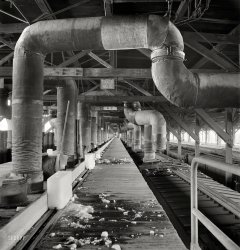
- Arnold Park: 1905
- ... very long but I do remember it having more trees and railroad tracks than any city of its size.
There's one in every ... The neighbor who piles up trash in his front yard. In Arnold Park, he lives in the house on the far left.
Champagne ... Posted by Dave - 08/01/2012 - 1:42pm -
![Arnold Park: 1905 Circa 1905. "Arnold Park -- Rochester, New York." 8x10 inch dry plate glass negative, Detroit Publishing Company. View full size.
This looks like the spotFirst pass through from the end, and the stonework entrance is still there.
View Larger Map
DrivewaysIt took me a while to realize there are no driveways on this street, only narrow curb cuts that must be for bicycles or wagons or pushcarts or something. My 21st Century mind kept telling me those were driveways until I looked closer. No cars? No driveways yet.
[Actually the words "driveway" and "driving" are products of the carriage-and-buggy era. Some of these homes may have had carriage houses with driveways to the street. Also note the curbside mounting blocks and hitching posts. - Dave]
Rochester MemoriesI didn't live in Rochester very long but I do remember it having more trees and railroad tracks than any city of its size.
There's one in every neighborhoodThe neighbor who piles up trash in his front yard. In Arnold Park, he lives in the house on the far left.
Champagne Anyone
Beautiful American Elm trees. Not may left in our cities any more due to dutch elm disease. What a shame!
Trees are mapleThose aren't Elm. Look at the leaves....those are all Sugar Maple.
(The Gallery, Rochester)](https://www.shorpy.com/files/images/SHORPY_4a18731a.thumbnail.jpg)
- Instant Message: 1942
- ... Illinois. These pneumatic tubes in the Illinois Central Railroad yardmaster's office connect him with the general office." ... the late 70s, just as the caption says: connecting several yard offices with the central office. I have to wonder if Milwaukee officials ... Posted by Dave - 04/26/2013 - 11:47am -
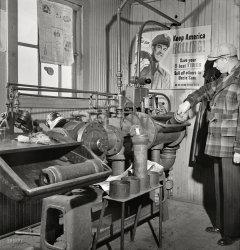
- Compleat Angler: 1901
- ... did to your enemy was maybe TP the trees in their front yard. That always showed 'em!
Regarding the fishing, he's probably fishing ... get stuck on them.
Bridge Supports The Pennsylvania Railroad and her subsidiaries would typically build bridges in this manner, ... Posted by Dave - 04/12/2015 - 8:48am -
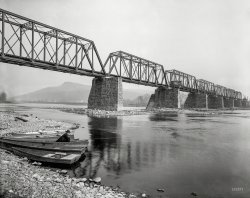
- Central Furnace Works: 1908
- ... the materials to Emma via the Newburgh & South Shore railroad. I read that rail service to the Emma furnaces was discontinued in the ... were built in 1908 at a brand new ore dock and storage yard that was located south of the Central Furnace plant, the Hulett dock being ... Posted by Dave - 10/12/2012 - 5:52pm -
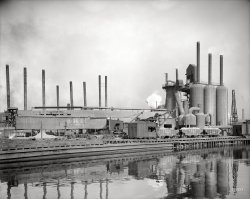
- Through to Morgantown: 1905
- ... (second boat with that name) built in 1895 at the Howard yard in Jeffersonville, Indiana. A bit of a mystery, according to Way's Packet ... They are probably the beginnings of the Wabash (Railroad) Bridge built between 1902 & 1904, possibly fitting the "Circa ... Posted by Dave - 05/15/2017 - 3:33pm -
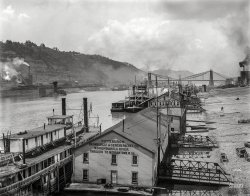
- Newport News: 1905
- ... you can see the one "rise" on Washington Street where the railroad goes under at 40th Street from the Newport News shipbuilding yard.
Immaculate Nary a horse apple apparent! One need not wonder about ... Posted by Dave - 09/03/2015 - 10:47am -
![Newport News: 1905 1905. "Washington Avenue, Newport News, Virginia." A lesson in receding lines of perspective. 8x10 inch glass negative, Detroit Publishing Co. View full size.
Around Washington and 30thOff in the distance you can see the one "rise" on Washington Street where the railroad goes under at 40th Street from the Newport News shipbuilding yard.
ImmaculateNary a horse apple apparent! One need not wonder about the efficiency of this city's street sweepers!
27th and WashingtonYou can just make out the street sign on the corner of the building with the arch on the left. I compared this to an old photo from around that time taken in the same direction from 26th street and the roofs of the buildings matched up. All gone now.
Ma Bell?Given all the cables coming out of the building at right I think we can assume the Newport News telephone exchange is located there. Usually such trunk lines are run underground until they get out of the business district.
Ma Bell's DomicileIf you use the enlarged photo, then enlarge that some more, on the building on the right where the telephone trunk lines have been identified by a previous commenter (Zoreo), if you look just above the level of the tops of the doors, about transom level, and underneath where those four second-floor windows with the awnings folded back, directly under the second one, there appears to be a "Bell Telephone" logo type sign. And even though I can't make it out very clearly, I get the sense that the word straight across the top is "Telephone." Perhaps someone else can make it out a bit more clearly with better resolution.
["Pay Station"? -tterrace]
tterrace - Perhaps a station where you could place telephone calls requiring immediate payment as they are made, before the existence of telephone booths? Or, maybe a place ("station") where one could pay their phone bill if they were fortunate enough to have a home phone, phones in one's business establishment, or something similar?
(The Gallery, DPC, Stores & Markets)](https://www.shorpy.com/files/images/SHORPY-4a12456a.thumbnail.jpg)
- Spring Planting: 1943
- ... 1943. Chicago, Illinois. "Chicago & North Western RR railroad workers cultivating a little Victory garden at the Proviso Yard." View full size. 4x5 Kodachrome transparency by Jack Delano for the ... Posted by Dave - 08/30/2012 - 4:42pm -
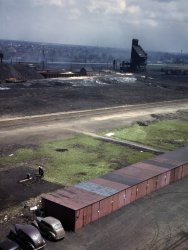
- Bicycle Crossing: 1943
- ... "Freight train operations on the Chicago and North Western Railroad between Chicago and Clinton, Iowa. The train rushing through the town ... is eastbound through Elmhurst, probably entering Proviso Yard. The tall bank building and other buildings can be seen on streetview. ... Posted by Dave - 12/11/2014 - 12:07pm -
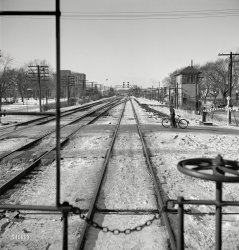
- Caboose Track: 1943
- ... track at the Chicago & North Western RR Proviso Yard." View full size. 4x5 Kodachrome transparency by Jack Delano for the ... of War Information.
No Graffiti! In all of the railroad pictures I have seen taken before 1990, I am pleased that graffiti ... Posted by Dave - 08/13/2012 - 4:34pm -
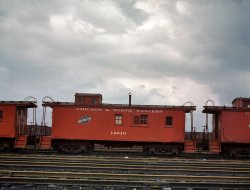
- Snowy Joliet: 1943
- ... An important ancillary building once found in nearly every yard, but now less common, was the scale house.
Most cars containing bulk ... to determine the weight for transportation charges by the railroad, and often for the charges the shipper would bill their customer for ... Posted by Dave - 12/24/2014 - 10:50am -
![Snowy Joliet: 1943 March 1943. "Joliet, Illinois. Leaving the Atchison, Topeka & Santa Fe railyard." Photo by Jack Delano for the Office of War Information. View full size.
Can't quite make it outKeep the door closed when ??????????? cars.
[Illegible in the original. -tterrace]
Sign, sign, everywhere a signMy take:
KEEP THIS DOOR
CLOSED WHEN NOT
WEIGHING CARS
Mixed Signals?That looks like a train order signal. Not motorized, each blade appears to be manually operated by means of a pipe that extends down each side of the mast to just above the ground and then... nowhere. No trackside racks for delivering orders/messages on the fly, no telegraph office visible... are there any Santa Fe experts out there who know what this signal might have been for?
WestboundMr. Delano was looking back from the caboose of a westbound train; the view is actually NNE. Des Plaines River/Sanitary and Ship Canal to the left, EJ&E bridge and Joliet Coke Plant in the background.
The Scale HouseAn important ancillary building once found in nearly every yard, but now less common, was the scale house.
Most cars containing bulk commodities such as grain, coal, and such were weighed - both to determine the weight for transportation charges by the railroad, and often for the charges the shipper would bill their customer for the merchandise. Every car had (has) the empty weight of the car stenciled on the side of the car, and the switching crew and a clerk would weigh each car, and subtract the Lt Wt (Light Weight, as stenciled) to determine the weight of the contents, and attach the scale ticket to the Bill of Lading.
Note that there are four rails past the scale house. The Live Rails were for weighing the cars, the Dead Rails (or Bypass Rails) were so that engines could pass the scale without using the Live Rails, since their weight often exceeded the capacity of the scale.
(The Gallery, Jack Delano, Railroads)](https://www.shorpy.com/files/images/SHORPY-8d26313u.thumbnail.jpg)
- Career Track: 1943
- February 1943. "Women in essential services. Women railroad workers take over the care and maintenance of freight and passenger ... escorts to provide her the needed access to the railroad yard. The man with the hat could be a Union Pacific employee. The other man ... Posted by Dave - 07/04/2017 - 1:02am -
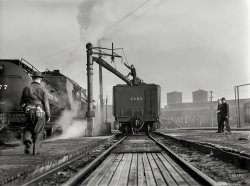
- Chicago and North Western: 1942
- ... General view of one of the Chicago and North Western railroad yards at Chicago. December 1942. View full size. 4x5 Kodachrome ... To the left it heads south to Bellwood. North of this yard (check out how big it still is today on Google Maps satellite view!) is ... Posted by Dave - 08/05/2012 - 9:30am -
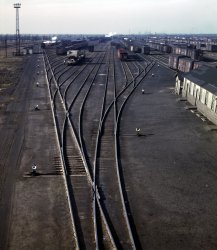
- City Terminal: 1941
- ... a major modification after the war when they removed the railroad yard and the terminal switched to purely truck distribution.
(The Gallery, ... Posted by Dave - 01/31/2020 - 9:25pm -
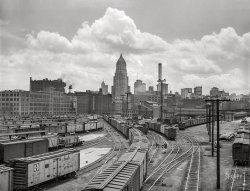
- Coal, Water, Sand: 1942
- ... up with coal, water and sand at an Illinois Central Railroad yard before going out on the road." Medium-format negative by Jack Delano for ... Posted by Dave - 12/30/2013 - 12:29pm -
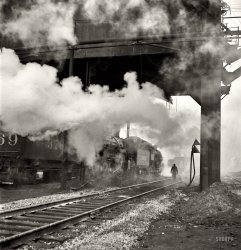
- Telluride Tracks: 1940
- ... in her later years as a switcher in the Durango, Colorado yard, finally meeting the scrapper’s torch in 1954.
The last two ... in operation: #463 on the Cumbres & Toltec Scenic Railroad running between Antonito, CO and Chama, NM, and #464 on the ... Posted by Dave - 06/22/2019 - 9:34am -
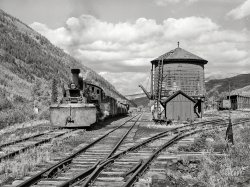
- Freedom Factory: 1941
- ... is nowadays dominated by a very large Norfolk Southern railroad yard and the four tanks mentioned above are just north of the Monaca - East ... Posted by Dave - 08/05/2021 - 11:34pm -
